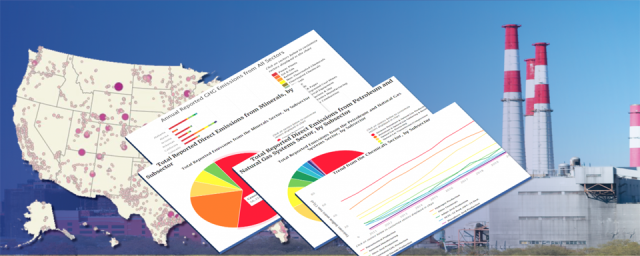Climate Change Regulatory Actions and Initiatives
EPA is taking action to address some of our nation’s largest sources of both climate- and health-harming pollution, such as the transportation, oil and natural gas, and power sectors. EPA will continue to update this information as we move forward with new regulatory actions.
On this page:
- High Global Warming Chemicals
- Transportation/Mobile Sources
- Stationary Sources
- Greenhouse Gas Reporting
- Greenhouse Gas Endangerment and Cause or Contribute Findings
High Global Warming Chemicals

Hydrofluorocarbons (HFCs) are fluorinated chemicals commonly used as replacements for ozone-depleting substances in applications such as air conditioning, refrigeration, fire suppression, solvents, foam blowing agents, and aerosols. HFCs are highly potent greenhouse gases with global warming potentials that can be hundreds to thousands of times greater than carbon dioxide (CO2).
The American Innovation and Manufacturing (AIM) Act of 2020 directs EPA to address HFCs by providing new authorities to phase down the production and consumption of listed HFCs, manage these HFCs and their substitutes, and facilitate the transition to next-generation technologies that do not rely on HFCs.
On September 23, 2021, EPA issued a final rule establishing the HFC Allocation program that will phase down the U.S. production and consumption of HFCs by 85% from historic levels by 2036, as mandated by the AIM Act. A global phasedown of HFCs is expected to avoid up to 0.5°C of global warming by 2100. The Emissions Reduction & Reclamation program to manage HFCs and substitutes was established in October 2024. The Technology Transitions program issued its first rule putting in place restrictions on HFCs in over 40 subsectors in October 2023.
- Learn more about HFCs, the AIM Act, and EPA regulations under AIM.
Transportation/Mobile Sources
Emissions and Fuel Use Standards for New Light-Duty and Heavy-Duty Motor Vehicles

On December 20, 2021, EPA finalized federal greenhouse gas emissions standards for passenger cars and light trucks for Model Years (MY) 2023 through 2026. The final standards leverage advances in clean car technology to unlock $190 billion in net benefits to Americans, including reducing climate pollution, improving public health, and saving drivers money at the pump. These standards are the strongest vehicle emissions standards ever established for the light-duty vehicle sector, and are based on sound science and grounded in a rigorous assessment of current and future technologies. The updated standards will result in avoiding more than 3 billion tons of GHG emissions through 2050. Learn more about the light-duty vehicle final rule.
On March 20, 2024, EPA announced a final rule, Multi-Pollutant Emissions Standards for Model Years 2027 and Later Light-Duty and Medium-Duty Vehicles, that sets new, more protective standards to further reduce harmful air pollutant emissions from light-duty and medium-duty vehicles starting with model year 2027. The final rule builds upon EPA’s final standards for federal greenhouse gas emissions standards for passenger cars and light trucks for model years 2023 through 2026 and leverages advances in clean car technology to unlock benefits to Americans ranging from improving public health through reducing smog- and soot-forming pollution from vehicles, to reducing climate pollution, to saving drivers money through reduced fuel and maintenance costs. These standards will phase in over model years 2027 through 2032.
On March 29, 2024, the U.S. Environmental Protection Agency (EPA) announced a final rule, “Greenhouse Gas Emissions Standards for Heavy-Duty Vehicles – Phase 3,” that sets stronger standards to reduce greenhouse gas emissions from heavy-duty (HD) vehicles beginning in model year (MY) 2027. The new standards will be applicable to HD vocational vehicles (such as delivery trucks, refuse haulers, public utility trucks, transit, shuttle, school buses, etc.) and tractors (such as day cabs and sleeper cabs on tractor-trailer trucks).
The final “Phase 3” standards build on EPA’s Heavy-Duty Phase 2 program from 2016 and maintain that program’s flexible structure, which is designed to reflect the diverse nature of the heavy-duty vehicle industry. The standards are technology-neutral and performance-based, allowing each manufacturer to choose what set of emissions control technologies is best suited for them and the needs of their customers.
Greenhouse Gas Standards for Aircraft
EPA is implementing CO2 emission standards for airplanes used in commercial aviation and for large business jets. These standards are consistent with international standards set by the United Nations' International Civil Aviation Organization. Learn more about greenhouse gas standards for aircraft.
Renewable Fuel Standard Program
EPA is also responsible for implementing the Renewable Fuels Standard Program, a national policy that requires a certain volume of renewable fuel to replace petroleum-based transportation fuel.
Stationary Sources
Oil and Natural Gas

The oil and natural gas sector is the nation’s largest industrial source of methane, another potent greenhouse gas with a global warming potential that is 28 to 36 times greater than that of CO2 over the first hundred years after it is emitted. EPA’s Clean Air Act requirements for the oil and natural gas industry help combat climate change and reduce emissions of other harmful air pollutants, including volatile organic compounds that contribute to ground-level ozone (“smog”) and hazardous air pollutants such as benzene.
On December 2, 2023, EPA announced a final rule that will sharply reduce emissions of methane and other harmful air pollution from oil and natural gas operations — including, for the first time, from existing sources nationwide. The final action includes New Source Performance Standards to reduce methane and smog-forming volatile organic compounds from new, modified and reconstructed sources. It also includes Emissions Guidelines, which set procedures for states to follow as they develop plans to limit methane from existing sources.
On November 12, 2024, EPA announced a final rule to reduce methane emissions from the oil and gas sector. The rule facilitates implementation of Congress’s directive in the Inflation Reduction Act (IRA) to collect a Waste Emissions Charge (WEC) on methane emissions from oil and natural gas facilities that exceed specific levels of emissions and methane intensity specified in the IRA. The WEC will work in concert with EPA’s Clean Air Act rules for oil and natural gas facilities, and with other provisions of the IRA, including financial and technical assistance and updates to the Greenhouse Gas Reporting Program, to incentivize and encourage reductions in harmful air pollution and waste from oil and natural gas operations. The final rule includes calculation procedures, exemptions, and reporting requirements related to the WEC.
Power Plants
EPA implements several health protections that affect power plants and reduce conventional air pollutants through the Acid Rain Program (ARP), the interstate air pollution transport programs, the Mercury and Air Toxics Standards (MATS), and new source performance standards for criteria pollutants. As a result of these programs, fossil fuel-fired electric generating units reduce emissions of sulfur dioxide (SO2), nitrogen oxides (NOx), and hazardous air pollutants, including mercury (Hg), to protect human health and the environment—and in doing so often adopt measures that reduce CO2 emissions as well.
Despite significant progress in reducing greenhouse gas pollution, existing coal-fired power plants remain the largest source of greenhouse gases from the power sector, and new natural gas-fired combustion turbines are some of the largest new sources of greenhouse gas being built.
Carbon Pollution Standards for New and Existing Fossil Fuel-Fired Power Plans
In 2015, EPA issued a final rule establishing emission standards for greenhouse gas emissions from new fossil fuel-fired utility boilers and natural gas-fired stationary combustion turbines.
In May 2024, EPA published final carbon pollution standards for power plants that set carbon dioxide (CO2) limits for new gas-fired combustion turbines and CO2 emission guidelines for existing coal, oil and gas-fired steam generating units, securing important climate benefits and protecting public health. These rules will significantly reduce greenhouse gas (GHG) emissions from existing coal-fired power plants and from new natural gas turbines, ensuring that all long-term coal-fired plants and base load new gas-fired plants control 90% of their carbon pollution.
New and Existing Municipal Solid Waste Landfills
Methane is a potent greenhouse gas. In 2016, EPA finalized two rules updating both the 1996 New Source Performance Standards (NSPS) for new and modified landfills and the 1996 guidelines for existing landfills to reduce emissions of methane-rich landfill gas. EPA issued a Federal Plan implementing the 2016 emission guidelines in May 2021.
Greenhouse Gas Reporting
Greenhouse Gas Reporting Program

The Greenhouse Gas Reporting Program collects greenhouse gas data from large emission sources across a range of industry sectors, as well as suppliers of products that would emit greenhouse gases if released or combusted. Under the Clean Air Act (40 CFR Part 98), facilities that meet reporting thresholds must report greenhouse gas emissions to the program annually. Greenhouse gas data are available through a number of portals, including the Facility Level Information on GreenHouse gases Tool (FLIGHT).
On April 25, 2024, EPA finalized amendments to the GHGRP in a rule that updates global warming potentials (GWPs), expands the GHGRP to new source categories, and revises the requirements for certain sectors to improve the data collected and program implementation.
On May 14, 2024, EPA finalized amendments to Subparts A (General Provisions), C (Stationary Combustion) and W (Petroleum and Natural Gas Systems) of the GHGRP in a rule to incorporate changes called for under the Inflation Reduction Act, address gaps in reporting of emissions data for specific sectors and establish confidentiality determinations for new or substantially revised data elements.
Power Sector CO2 Emissions
EPA collects detailed CO2 emissions data and other information from power plants across the country as part of the Acid Rain Program (ARP) and the interstate air pollution transport programs. Summary-level data are updated every quarter and available on the Power Plant Emission Trends page. Power Sector Programs Progress Reports provide annual summaries of emissions and environmental impacts. More detailed emissions data are available in the Clean Air Markets Program Data (CAMPD).
Greenhouse Gas Endangerment and Cause or Contribute Findings
On December 7, 2009, EPA issued a final action under Section 202(a) of the Clean Air Act finding that six key well-mixed greenhouse gases constitute a threat to public health and welfare, and that the combined emissions from motor vehicles cause or contribute to climate change. On July 25, 2016, EPA issued a final action under Section 231(a) of the Clean Air Act finding that emissions of the six well-mixed greenhouse gases from certain classes of engines used in aircraft also constitute a threat to public health and welfare and contribute to climate change.
